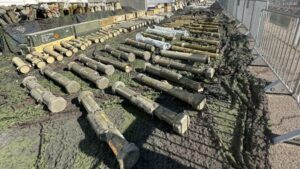In a significant policy shift, the United States has announced it will provide non-persistent anti-personnel land mines to Ukraine, a move aimed at bolstering Kyiv’s defenses amid evolving Russian tactics.
With reports from Reuters Wednesday, this marks a departure from the Biden administration’s previous stance on anti-personnel mines and highlights the complexity of supporting Ukraine in its ongoing struggle against Russian aggression.
Addressing a New Battlefield Dynamic
The decision comes as Ukraine faces intensified pressure on its eastern front. In recent months, Russian forces have shifted their strategy, leading with dismounted infantry instead of armored vehicles.
Defense Secretary Lloyd Austin explained to reporters on Wednesday that this adaptation has necessitated a recalibration in Ukraine’s defense tactics.
“What we’ve seen most recently is because the Russians have been so unsuccessful in the way that they have been fighting, they’ve kind of changed their tactics a bit,” Austin said, cited from Defense One. “…they don’t lead with their mechanized forces anymore.”
By employing smaller, dispersed units to pave the way for mechanized forces, Russia is exploiting gaps in traditional anti-tank measures, making anti-personnel mines an effective countermeasure.
In a significant policy shift, the United States has announced it will provide non-persistent anti-personnel land mines to Ukraine, a move aimed at bolstering Kyiv’s defenses amid evolving Russian tactics.
With reports from Reuters Wednesday, this marks a departure from the Biden administration’s previous stance on anti-personnel mines and highlights the complexity of supporting Ukraine in its ongoing struggle against Russian aggression.
Addressing a New Battlefield Dynamic
The decision comes as Ukraine faces intensified pressure on its eastern front. In recent months, Russian forces have shifted their strategy, leading with dismounted infantry instead of armored vehicles.
Defense Secretary Lloyd Austin explained to reporters on Wednesday that this adaptation has necessitated a recalibration in Ukraine’s defense tactics.
“What we’ve seen most recently is because the Russians have been so unsuccessful in the way that they have been fighting, they’ve kind of changed their tactics a bit,” Austin said, cited from Defense One. “…they don’t lead with their mechanized forces anymore.”
By employing smaller, dispersed units to pave the way for mechanized forces, Russia is exploiting gaps in traditional anti-tank measures, making anti-personnel mines an effective countermeasure.
What Are Non-Persistent Land Mines?
Unlike traditional mines, which remain a hazard long after a conflict ends, the non-persistent mines being sent to Ukraine deactivate after a predetermined period—anywhere from 4 hours to 2 weeks. Electrically fused and battery-powered, these mines are designed to mitigate the long-term risk to civilians.
The US has sought assurances from Ukraine that these mines will only be used within its territory and away from populated areas.
Ukrainian officials have committed to these terms, emphasizing their intent to use the mines strictly for defensive purposes.
Balancing Strategic Needs and Humanitarian Concerns
The use of anti-personnel mines is highly controversial. Over 100 nations have signed the Ottawa Convention, which bans the production, use, and transfer of such weapons.
While the United States is not a signatory to the treaty, the Biden administration had previously aligned its policy with key provisions of the agreement, limiting the use of anti-personnel mines outside the Korean Peninsula.
This policy shift reflects the delicate balance between addressing Ukraine’s immediate tactical needs and maintaining a commitment to minimizing civilian harm.
Critics, including humanitarian groups, argue that any use of land mines poses significant risks, especially in densely populated areas.
However, US officials contend that the non-persistent nature of these mines, combined with Ukraine’s pledges, reduces potential harm.
Countering Russian Mine Warfare
Russia’s extensive use of anti-personnel mines in Ukraine has exacerbated the challenge.
Unlike the non-persistent mines being sent by the US, many of Russia’s mines are designed to remain active indefinitely, creating a long-term threat to civilians and infrastructure.
A US official noted that Ukraine’s eastern regions are already littered with Russian mines, requiring post-conflict remediation efforts.
The US has committed to supporting these demining operations, emphasizing that its aid is not just about helping Ukraine win the war but also about addressing the humanitarian fallout.
A Broader Shift in US Policy
The decision to send anti-personnel mines is the latest in a series of policy adjustments by the Biden administration regarding military aid to Ukraine.
In recent months, the US has approved the use of long-range American weapons to strike within Russian territory and provided controversial munitions like cluster bombs and depleted uranium rounds.
These decisions reflect the increasingly high stakes of the war in Ukraine and the evolving nature of US support.
The introduction of non-persistent mines is part of a broader strategy to equip Ukraine with the tools it needs to counter Russian advances effectively.
Final Thoughts
While the US aims to help Ukraine gain a tactical edge, the decision to provide anti-personnel mines underscores the moral and logistical complexities of modern warfare. Balancing Ukraine’s defense needs with long-term humanitarian considerations will remain a delicate task as the war continues.
As the conflict grinds on, the United States’ commitment to Ukraine shows no sign of wavering. By adapting its policies to meet the realities on the ground, the US sends a clear message: it stands ready to provide the resources necessary to counter Russian aggression, even when those resources push the boundaries of traditional policy.
This decision may not be without controversy, but it reflects the urgent need to address the realities of a changing battlefield while preparing for the long-term recovery of a nation ravaged by war.



